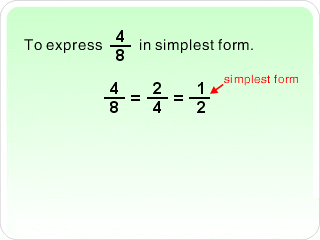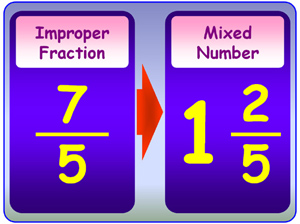1. You need to write decimal numbers in word form. (example: 324.42 is three hundred twenty four AND forty-two hundredths)
2. You need to know the value of a digit in a decimal number. For example, in 3.456, the 4 is worth 4 tenths, the 5 is worth 5 hundredths, and the 6 is worth 6 thousandths.
3. You need to compare decimal numbers using <,>, or =. For example, 3.5 = 3.50, but 3.5 > 3.05, and 3.5 < 2 =" 6." style="display:block; margin:0px auto 10px; text-align:center;cursor:pointer; cursor:hand;width: 500px; height: 500px;" src="http://upload.wikimedia.org/wikipedia/commons/thumb/4/4f/PieChartFraction_threeFourths_oneFourth-colored_differently.svg/500px-PieChartFraction_threeFourths_oneFourth-colored_differently.svg.png" border="0" alt="">
10. You need to be able to write a fraction in the simplest form. Here's an example:

11. You should understand the difference between irregular fractions and mixed numbers.

This picture shows a mixed fraction, 2 1/3:

12. You need to be able to make irregular fractions into mixed numbers and mixed numbers into irregular fractions. To make an irregular fraction a mixed number, you divide the top number (the numerator) by the bottom number (the denominator). So, 10/5 would be 10 divided by 5, which equals 2. 12/11 would be 12 divided by 11, which equals 1 with a remainder of 1, so the answer would be 1 1/11.
To make a mixed number an irregular fraction, you multiply the bottom number times the whole number and add the top number. So, 1 2/3 is 3x1 +2, which equals 5/3.
13. You need to be able to compare fractions using <, >, and =. So, which is bigger 1/2 or 2/3? You need to find a common denominator (use six for this problem). Multiply 1/2 by 3 and 2/3 by 2. You get 3/6 and 4/6. That means 2/3 > 1/2.
14. You need to be able to change decimal numbers into fractions. For example, 0.25 is 25/100, and that can be simplified to 5/20, which can be simplified to 1/4. (Or you can divide 25/100 by 25 and get 1/4!)
I'm posting the answers to the review in just a minute!

No comments:
Post a Comment